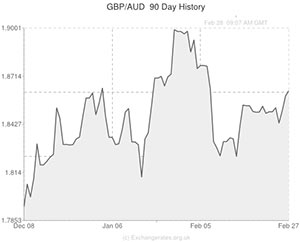
After a week of tension in the Ukraine a risk-off environment prevailed and the Australian Dollar was heading for a five-day decline against peers like the Pound and US Dollar.
Some disappointing domestic data and developments in the US also contributed to the ‘Aussie’s decline.
The commodity-driven currency drifted lower as Federal Reserve Chairwoman Janet Yellen asserted that the Fed will continue gradually tapering stimulus over the next few months despite the soft US data seen in recent weeks.
Meanwhile, a report published on Thursday showed a whopping 5.2 per cent drop in Australian capital spending and data released overnight showed that private sector credit eased from a gain of 0.5 per cent in December to an increase of 0.4 per cent in January. Economists had expected no change.
The Pound, meanwhile, ended the week on a little high as a gauge of UK consumer confidence came in at -7 in February, unchanged from the previous month and in line with expectations, while a separate report detailed a stronger-than-forecast increase in UK house prices.
The Nationwide report showed that house prices climbed by a seasonally adjusted 0.6 per cent in February, month-on-month, following a positively revised gain of 0.8 per cent in January. Economists had predicted a 0.5 per cent increase.
The annual increase of 9.4 per cent was the strongest annual gain since May of 2010.
Nationwide economist Robert Gardner said this of the result; ‘Price growth is being supported by the fact that the supply of housing remains constrained, with housing completions still well below their pre-crisis levels, which was already insufficient to keep up with the pace of household formation.’
Next week GBP/AUD movement may be inspired by Australia’s AiG performance of manufacturing index, Australian new home sales figures, China’s manufacturing/non manufacturing PMI, UK manufacturing/services PMI, the Reserve Bank of Australia’s rate decision, Australian growth data and Australian trade balance/retail sales figures.
Although the RBA is expected to leave interest rates unaltered when it meets last week, the central bank may choose to temper the hawkish rhetoric adopted at its last meeting in light of recent developments.
On Saturday China will release its manufacturing PMI for February. The measure is expected to have fallen from 50.5 in January to 50.1 in February – dangerously close to the 50 mark separating growth from contraction. If this proves accurate, or if the index slips below 50, Australia’s economic outlook will be dented and the Australian Dollar could weaken further.
Australian Dollar (AUD) Exchange Rates
[table width=”100%” colwidth=”50|50|50|50|50″ colalign=”left|left|left|left|left”]
Currency, ,Currency,Rate ,
Australian Dollar, ,US Dollar, 0.8962,
,US Dollar, 0.8962,
Australian Dollar, ,Euro, 0.6539,
,Euro, 0.6539,
Australian Dollar, ,Pound, 0.5360,
,Pound, 0.5360,
Australian Dollar, ,New Zealand Dollar, 1.0655,
,New Zealand Dollar, 1.0655,
US Dollar, ,Australian Dollar, 1.1157,
,Australian Dollar, 1.1157,
Euro, ,Australian Dollar, 1.5294,
,Australian Dollar, 1.5294,
Pound Sterling, ,Australian Dollar, 1.8673,
,Australian Dollar, 1.8673,
New Zealand Dollar, ,Australian Dollar, 0.9366,
,Australian Dollar, 0.9366,
[/table]

Comments are closed.